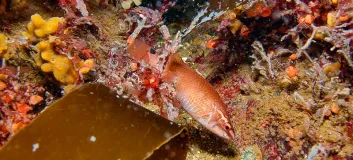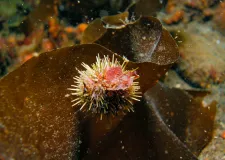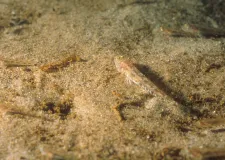Fehmarn Belt NCA
Brief description
The approximately 280 km² Fehmarn Belt Nature Conservation Area (NCA) is located in the western Baltic Sea, about 5 km north of the island of Fehmarn. It encompasses an up to 35 m deep strait of the same name situated between Germany and Denmark, through which 70–75% of the water exchange takes place between the North Sea and the Baltic Sea. Because of these particular hydrological conditions, the protected area has a key ecological function for the exchange and spread of marine species in the Baltic Sea.
Due to its western location, the NCA is home to most of the ‘true’ marine species that tolerate or even depend on higher water salinity when compared to the other two offshore nature conservation areas in the German Baltic Sea.
The southern section of the Fehmarn Belt NCA is characterised by large sand ripples – rare megaripples – that rise as high as 3 m from the seabed. The rocky reefs in the protected area are home to some of the most species-rich communities in the German Baltic Sea. The extensive silty bottom layers in the eastern section are also characteristic of the NCA.
Pressures and management
Like the Baltic Sea overall, the protected area suffers from eutrophication and the effects of climate change, such as rising water temperatures and the associated biochemical changes that take place in the marine environment. These effects are already being felt in the ecological communities. For example, macroalgae only occur in shallow waters because the water turbidity has significantly increased, thereby reducing the availability of light.
The most intensive use of the Fehmarn Belt NCA relates to shipping, because the area is traversed from west to east over a width of 4 km by one of the main shipping traffic separation schemes in the Baltic Sea. In more than half of the area, the mean density of shipping traffic is 30 to 80 ships per km² per day. The main negative impacts affect marine mammals, and especially harbour porpoises. Seabirds are also affected as they are startled or driven away by oncoming ships.
The area has been heavily used for both commercial and recreational fishing. Under the legislation establishing the protected area, a fishing prohibited zone has therefore been established for recreational fishing in the western part of Fehmarn Belt. The approximately 65 km² area is closed to recreational fishing all year round. It is home to reefs and sandbanks of high conservation value, which also provide important nursery habitats for juvenile fish. Under the provisions of the EU Common Fisheries Policy (CFP), and as a result of years’ long efforts on the part of the BfN, restrictions were imposed on commercial fishing in the Fehmarn Belt NCA in November 2024.
Protected area management aims to ensure the survival and reproduction of the species and habitats listed in the Birds and Habitats directives through measures to prevent adverse effects and implement restoration activities.
Facts and figures
| Name | Habitats Directive SAC | EU Code | Size |
|---|---|---|---|
| Fehmarnbelt | Habitats Directive SAC | DE 1332-301 | 280 km² |
| Species and habitats | Size or figures (2024) | |
|---|---|---|
| Protected benthic habitats/areas | Sandbanks (Habitats Directive habitat type, article 30 habitat (BNatSchG)) | 6.3 km² |
| Reefs | 113.3 km² | |
| Species/number | Harbour porpoise (Phocoena phocoena) | > 100, plus seasonal visits by migrants |
Common seal (Phoca vitulina) | Area used as a feeding habitat |
Character
The area is characterised by sandbanks of high conservation value and species-rich reef communities with natural populations of macroalgae. It provides ideal breeding and rearing grounds for a wide range of fish species. Marine mammals use Fehmarn Belt as a migration corridor and feeding ground.
With a crest height of up to 3 m, the megaripples located in the southern section of Fehmarn Belt are a special form of the sandbanks habitat type and, given their rarity, are of particular geoscientific and ecological value. They are populated by small-scale, heterogeneous, species-rich benthic communities that include such characteristic species as Astarte bivalves (Tridonta ssp.).
The extensive silty bottom layers in the eastern section are home to the endangered ocean quahog (Arctica islandica), which is able to survive the depleted oxygen supply that in the summer months can extend from the deep basins of the Baltic Sea into coastal waters.
The reefs located in the protected area comprise boulder fields with dense glacial boulder deposits. These are colonised by brown and red algae down to considerable depths. The extensive growths of algae are an essential feature of the Fehmarn Belt reefs. Together with hornwrack (Flustra folicea) and mermaid’s glove (Haliclona oculata), they are important in providing structure and habitats for numerous other organisms. This is how benthic communities that are extremely species-rich for the Baltic Sea are able to develop on the boulders and coexist among macrophytes. Given constant, favourable environmental conditions, especially sensitive and long-living species such as the common whelk (Buccinum undatum) and red whelk (Neptunea antiqua) can also be found on the reefs. These species no longer occur further to the east. This also emphasises the comparatively high salinity in the Fehmarn Belt NCA and its importance for the composition of species communities.
The rich supply of food offered by the sandbanks and reefs, the tidal current and water exchange in the Fehmarn Belt strait and the favourable oxygen levels and high biological production attract a wide range of fish. In addition to food, these fish also find shelter and spawning places between the boulders, which are densely covered with macroalgae. Numerous fish species live in the shelter of the reefs, from small goldsinny wrasse to large cod.
These in turn attracts harbour porpoises, the area being one of their most important feeding grounds. Harbour porpoises occur both in the protected area and in the waters in the immediate vicinity of Fehmarn. Mother-calf pairs are often sighted in the area, indicating the importance of the NCA for birthing and rearing of young harbour porpoises. Harbour seals are also attracted by the vast abundance of fish species and come to the NCA to forage for food. They belong to the Danish and South-Swedish harbour seal population and visit the area regularly to forage. Grey seals are frequently encountered there, too.





